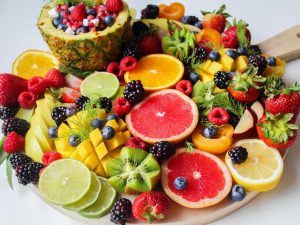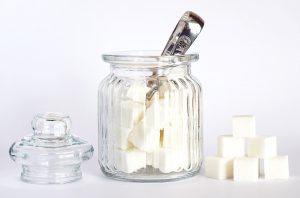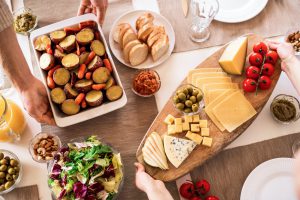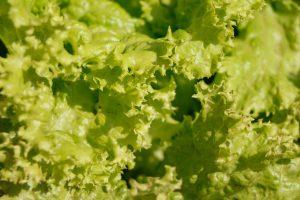What’s better than cozying up with a huge plate of spaghetti loaded with carbs or sinking your teeth into a nice, big sandwich? Not much. Unfortunately like most food, if it tastes good, chances are it’s bad for you. While carbohydrates aren’t horrible for you in moderation, if you go overboard on them there are some serious consequences such as high blood sugar, adrenal fatigue, bloating, and weight gain. Let’s learn more about what carbohydrates are and how you can substitute foods high in carbohydrates with smarter, lower carbohydrate options.
What is a carbohydrate?

Carbohydrates are a macronutrient found in many foods and beverages. Some carbs are naturally occurring while others are added by food manufacturers in the form of starch or added sugar. Common sources of naturally occurring carbohydrates include:
- Fruits
- Vegetables
- Milk
- Nuts
- Grains
- Seeds
- Beans, peas and lentils
3 types of carbohydrates

- Sugar. Sugar is the simplest form of carbohydrates and can be naturally occurring or added sugars. Naturally occurring sugar is found in fruits, vegetables, milk, and milk products. Added sugars are those added during processing such as sugar added to cookies or cakes.
- Fiber. Fiber is a type of carbohydrate found in plant foods. It occurs naturally in fruits, vegetables, whole grains, cooked dry beans, and peas.
- Starch. Starch is a complex carbohydrate and is naturally occurring in vegetables, grains, and cooked dry beans and peas.
Just because sugar, fiber, and starch are all categorized as carbs does not mean they’re all created equal. Sugar is a simple carb and breaks down into sugar fast, giving it the reputation for being a “bad” carb. Fiber and starch are complex carbs and are considered “good” carbs. Eating them helps keep your energy even and stabilize your blood sugar. If you have a choice between a good or bad carb, definitely opt for a good one so your blood sugar doesn’t spike.
How many carbs are in common foods?
If you aren’t accustomed to looking at a nutrition label, finding and understanding information about carbs (or any other nutrients for that matter) can be overwhelming and confusing. The recommended daily carbohydrate intake for most adults, male or female, is between 225 and 325 grams of carbs per day. In order to get a feel for what ‘a lot’ of carbs is as opposed to something that is perceived to be low carb, here are a few examples of some foods and their carb count.

- Cheese 0g. If you’re looking for a great way to add flavor but no carbs, cheese is the perfect solution.
- Cauliflower 5.3g. While you may think that vegetables wouldn’t have carbs, most do and if you eat a lot of them, it does add up. At 5.3g that is really nothing in the grand scheme of things so get those veggies in.
- Big Mac 43.98g. It’s no surprise Big Macs have over 40g of carbs in them. They have huge buns and then they have a 3rd bun in the middle (as if a regular bun wasn’t enough).
- Slice of pizza 35g. When you think of carb-heavy foods, pizza is probably one of the first to come to mind, but at 35g per serving it’s not outrageous. The amount fluctuates depending on whether it’s it’s deep dish crust or thin crust, or if it’s a cauliflower crust vs. a regular crust, but 35g is a good reference point to see how it fares compared to other foods.
- Burrito-sized flour tortilla 70g. This is probably one of those foods that you think “wait – that can’t be right. 70 carbs for a little ol’ tortilla?” I’m sure you’re not alone. If you think about it, a tortilla is like a couple slices of bread squished down and compacted into a dense wrap so packing 70 grams of carbs
- 1 slice of white bread 24g. Most people eat 2 slices of bread with a sandwich, but most serving sizes are 1 slice. After all is said and done, you really are eating almost 50g of carbs if you make a sandwich for lunch, so keep that in mind next time you’re looking at a nutrition label.
- 1 serving of pasta 43.2g. Pasta is another food that you may associate being high in carbs and you wouldn’t be wrong. A serving size is approximately the size of a baseball so when you go out to eat at a restaurant you’re most likely getting more than a serving.
What are some good alternatives?
Now that you have a good grasp on how many grams of carbs you should be eating and the amount of carbs in foods you may eat, you may be wondering where you can cut some out or explore new substitutes that you may not have thought of before. Here are a few ideas to help get you started on phasing some low carb options into your diet.

- Lettuce wraps. These are a great alternative to using tortilla wraps or taco shells when you’re celebrating Taco Tuesday. Take a nice, big leaf of romaine and load it up with some ground turkey, beef, or tofu. You’ve already slashed most of the carbs you would’ve consumed had you gone the traditional wrap route so now you can have that extra taco.
- Low carb wraps. As mentioned earlier, a standard sized flour tortilla has 70g of carbs. There are so many new wrap options on the market that have a fraction of the carbs. You just need to be sure to read your labels and you will definitely be able to find a tasty alternative that is way less than 70g.
- Pickles. Say what now? Yep, you read that right. Those tangy, crispy sandwich sidekicks are having a moment and being hollowed out and being used as bread. It’s kind of genius if you like putting pickles on your sandwich anyway. Hate it ‘em or love ‘em, you can’t deny it’s a big dill for a new low carb option.
- Shirataki noodles. These noodle knockoffs are also called miracle noodles, and for good reason. One serving has 3g of carbs and are amazing dupes for regular pasta. They are made from an Asian plant called the konjac plant. Using them as a base for your favorite sauce or soup is a great way to get more bang for your carb buck, without sacrificing flavor.
- Chickpea pasta. One serving of this alternative to regular pasta has 34g of carbs but chock full of fiber and protein making it a great option if you’re in the mood for some pasta.
- Hold the bun. If you’re out and want a burger, ask to hold the bun and wrap it in a leaf of lettuce. You’ll save tons of carbs but not skimp on flavor. Same goes for sandwiches – most places will make the sandwich into a bowl so you can eliminate the roll altogether.
- No matter what your fitness or diet goals are, it’s always a good idea to be familiar with what you’re eating. When it comes to carbs, try to make smart decisions and see if you can tweak existing habits for lower carb options. The possibilities are endless and you can save your carbs for the good stuff, like a piece of cake or a glass of wine.